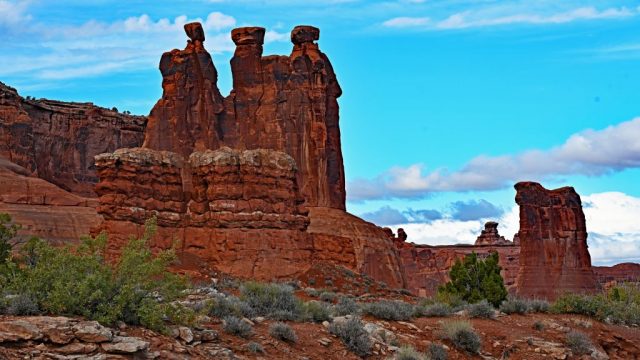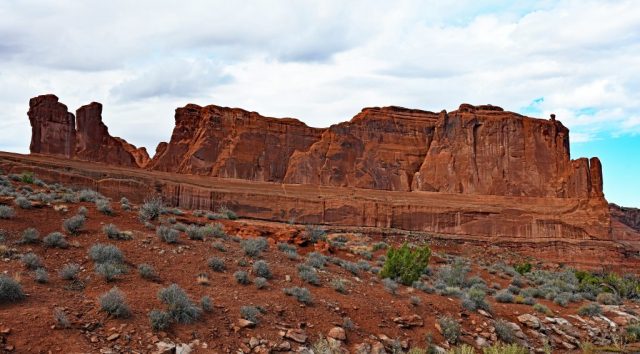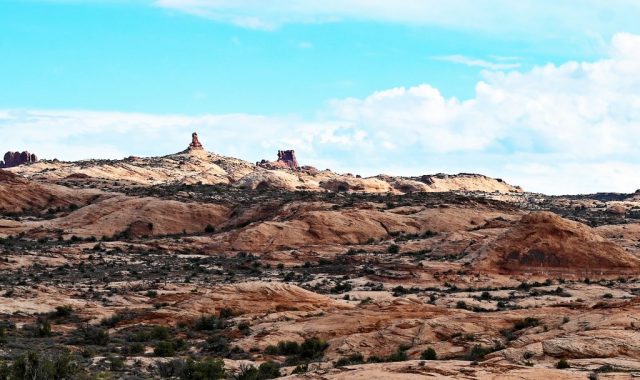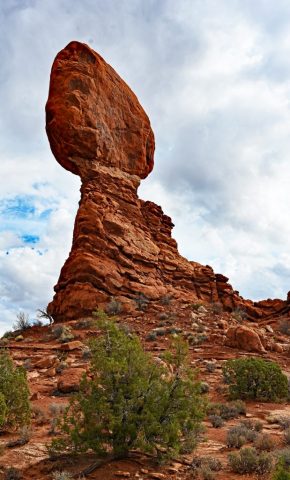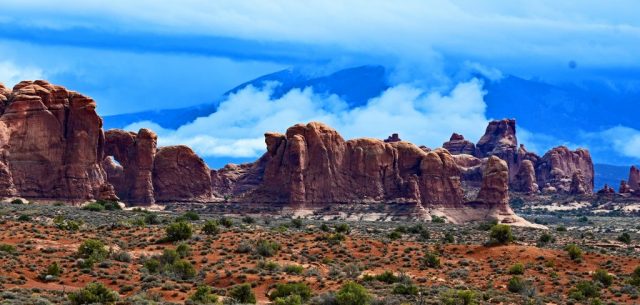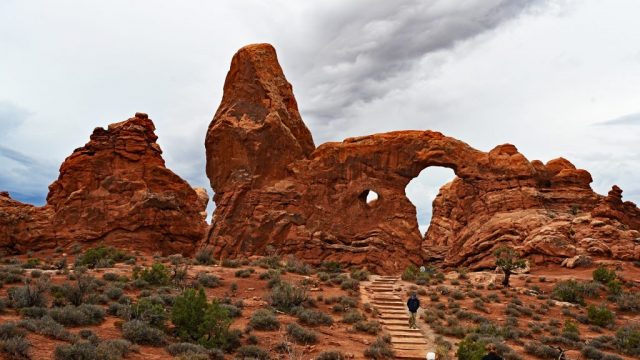23rd October 2025
Morning Light and Silent Stone
When I woke up this morning, I noticed the faint glimmer of moisture on the window. It had rained during the night. The air felt crisp and freshly washed, and though the sky remained thick with clouds, it was mercifully dry. After breakfast, I packed my luggage and drove toward Arches National Park. Because of the ongoing government shutdown, the park gates were open but unattended. Normally, I would have needed to book an online entry pass for two dollars and wait in line for ten or fifteen minutes. Today, I could simply drive through — a strange luxury in such a vast, regulated landscape.
The Three Gossips and the Organ
My first stop was at the Three Gossips, one of the park’s most recognizable formations. Rising 350 feet into the muted morning sky, these slender towers of Entrada Sandstone seemed to murmur secrets to one another. The sandstone here dates back between 180 and 140 million years, shaped by wind, rain, and time into vertical walls and sculpted fins. The reddish-orange rock was glowing softly, streaked with subtle purples and ochres beneath the grey sky — like embers just before dawn.
Across the open desert stood The Organ, an immense sandstone fin facing the Gossips as though listening to their ancient conversation. Between them, the silence was so complete that I could hear the faint wind whistling through the canyons — the voice of the desert itself.
Petrified Dunes and Hidden Pillars
A little further along the road, I stopped at the Petrified Sand Dunes — a landscape of solidified waves, frozen in mid-motion. The rolling curves of stone looked like a sea turned to rust-colored glass. Two hundred yards further, across the other side of the road, stood the Phallus Pillar. At first, I thought there might be a window carved through it, but curiosity made me retrace my steps. Closer inspection proved me wrong — what had looked like an opening was merely a shadow, a trick of light on the sculpted rock.
Farther up the road, on the left, the terrain rose into a cluster of rock pinnacles, glowing deep red as a thin shaft of sunlight pierced through the clouds. Their sharp silhouettes stood against the pale grey sky like the teeth of an ancient creature.
Balanced Rock – The Defiance of Gravity
Soon after, I reached Balanced Rock, one of the park’s icons. From a distance, it appears almost impossible — a massive boulder delicately poised atop a slender pedestal. In truth, the boulder of Entrada Sandstone is fused to its eroding base of Dewey Bridge mudstone. Together, they rise 128 feet (39 meters) into the sky, a sculpture of precarious balance and geological patience.
I walked around the formation slowly, taking photos from every angle. The red and tan layers contrasted sharply with the shifting clouds. The stillness of the stone against the moving sky was mesmerizing. This rock, weighing over 3,600 tons, has stood here for thousands of years, yet its balance is temporary. Nature’s slow hands are always at work — one day, the boulder will fall, just as its smaller twin, “Chip-Off-the-Old-Block,” did in the winter of 1975–76. That thought made me pause and look longer, grateful to see it now, before time claims it too.
The Windows Section – The Heart of Arches
By the time I arrived at the Windows Section, the sky had grown darker again, but I was lucky — I found a parking spot immediately. This part of the park is often called its “beating heart,” a compact area filled with some of the most majestic formations in just a few square miles. I followed both the Primitive Trail Loop and the Windows Trail, visiting North Window, South Window, and Turret Arch in succession. Each arch framed the desert beyond like a living painting — a window not only through stone but through time itself.
Behind the South Window, I discovered tall, narrow rock fins, their fluted sides gleaming wetly from the earlier rain. The colors had deepened — crimson, rust, and chocolate-brown blending into a vivid, almost surreal palette.
Double Arch and the Desert Storm
After a quick lunch at the car, I drove down to the Double Arch, another of Arches’ masterpieces. I climbed up the smooth sandstone slope to stand beneath its twin spans, their immense curves towering above me like the vault of a cathedral. Just as I lifted my phone to take a selfie, I felt the first cool raindrops on my face. I turned back immediately — wet sandstone can be treacherous.
Within minutes, the drizzle became a downpour, and by the time I reached the halfway point, hailstones were pelting down, stinging sharply on my arms. I ran the rest of the way, soaked to the skin but oddly exhilarated. Sitting back in the car, I watched the rain cascade off the rocks in silver streams. The red desert had turned into a landscape of rushing water. From the rear of the Double Arch, waterfalls poured through small holes in the stone — ephemeral and wild.
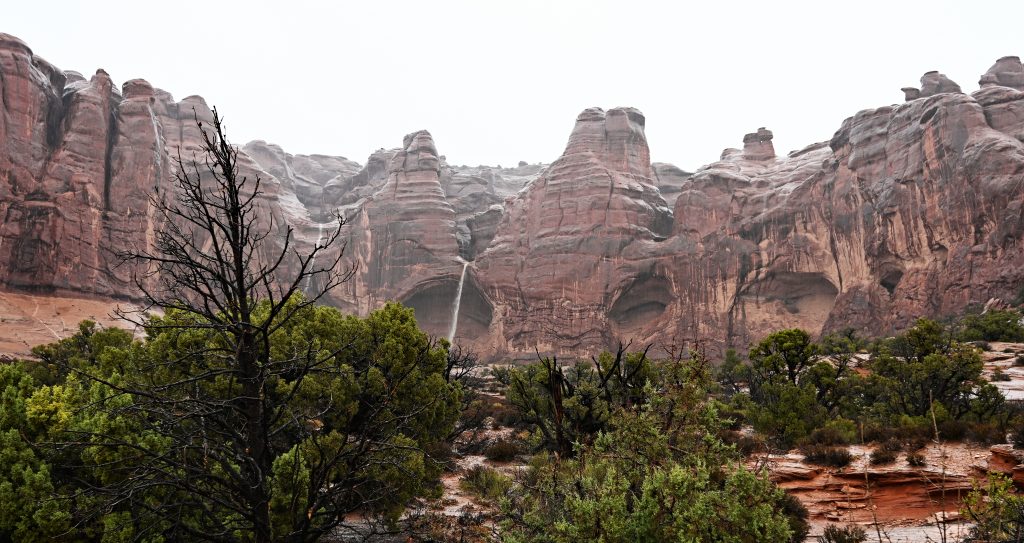
On the drive back, I passed the river near the Visitor Center, now swollen and muddy, flooding the lowlands. Fortunately, the road ran high above, safe from the torrent. As I looked out across the drenched landscape, the rain began to soften, and a faint glow appeared in the west — the promise of clearer weather ahead.

I hoped that tomorrow would bring sunshine, but even in the storm, the desert had shown its raw, untamed beauty. There is something profoundly humbling about watching water and stone converse — one carving, the other yielding, in a dialogue millions of years old.
